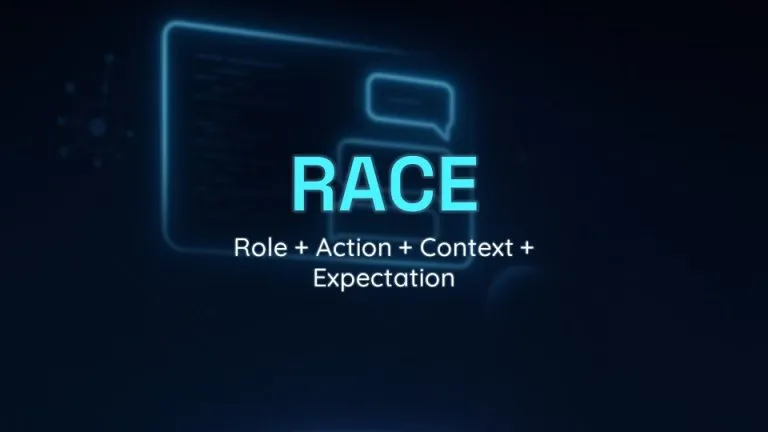RACE Framework: Role, Action, Context, Expectation

When you need a personalized, context-aware response with a clear outcome, the RACE framework is one of the most effective. It perfectly balances authority, direction, scenario, and objective — creating prompts that generate useful, realistic, and purpose-driven answers.
Whether solving a problem, analyzing a situation, or planning an action, RACE offers clarity and focus, making your communication with AI much more strategic.
What is the RACE Framework?
RACE is a complete four-part structure that balances action and context, helping the AI deliver detailed responses aligned with your needs. Each component plays a key role in making your request clear and well-directed. Let’s explore the elements and understand when to use them.
Structure Components
- Role: Defines who the AI should act as, such as “a sales strategist” or “a UX designer,” adjusting tone and expertise.
- Action: Specifies what you want the AI to do, like “create a plan” or “evaluate a process.”
- Context: Provides the background or setting, giving the AI the “where” and “why” of the task.
- Expectation: Describes the desired outcome, such as “a detailed analysis” or “practical suggestions.”
These elements come together to create a robust prompt that delivers useful, contextualized responses.
When to Use It?
RACE is ideal when you need a response that considers a specific scenario. Use it if:
- You want a personalized solution for a particular problem or situation.
- You need an analysis or plan that reflects contextual details.
- You seek depth without losing focus on the end goal.
For example: “As a [Role], [Action] considering [Context]. I expect [Expectation].”
Practical Examples of RACE in Action
To show how RACE works in practice, here are three examples applying the structure to real-life situations. See how it organizes ideas and delivers precise results.
Example 1: Promotion Strategy for Local Event
Context: You’re organizing an in-person event on a tight budget.
As a local marketing consultant (Role), create a promotion strategy for a free community event (Action). The context is a creative economy fair in a residential neighborhood, with a limited budget and a family-oriented target audience (Context). I expect feasible, low-cost suggestions focused on local engagement (Expectation).Why it works: The role sets the tone, the action defines the focus, and the scenario prevents unrealistic answers.
Example 2: Service Process Review
Context: You manage a support team that receives frequent complaints.
As a customer experience consultant (Role), evaluate our support process (Action) considering we receive many complaints about response times in a 5-person team (Context). I expect clear suggestions to improve efficiency (Expectation).Why it works: The Role brings expertise, the Action targets analysis, the Context details the problem, and the Expectation requests actionable results.
Example 3: Diagnosing Low Team Engagement
Context: You lead a team showing signs of low productivity and engagement.
As a team management expert (Role), analyze the situation and propose actions to boost engagement (Action). The context involves a remote team of 12 people across time zones, with no in-person meetings for 6 months (Context). I expect suggestions that improve motivation and sense of belonging (Expectation).Why it works: The AI considers both human and operational factors and delivers actions tailored to the remote environment.
Tips to Make the Most of RACE
RACE is versatile and can be customized to match exactly what you need. Here are some suggestions to adjust it for the best results.
Customize for Your Goal
- Role: Choose a role that reflects the ideal perspective. “A project manager” is different from “an informal mentor.”
- Action: Be specific in your request. “Give ideas” is vague, while “list 3 strategies” is clear.
- Context: Add relevant details. “A startup” changes the approach compared to “an established company.”
- Expectation: Define the outcome precisely. “Something useful” is broad; “a plan with deadlines” is focused.
Quick Example:
“As a financial planner (Role), suggest investment options (Action) considering I’m a young professional with a moderate income (Context). I expect 2 safe, long-term ideas (Expectation).”
Start Using RACE Today
RACE is a powerful tool for anyone seeking detailed and contextualized AI responses. It combines expertise, action, and scenario — ensuring your interactions with LLMs are productive and aligned with your goals. Whether solving problems, planning actions, or analyzing situations, this framework delivers results you can confidently apply.
🎯 Quick Summary: RACE defines who is responding (Role), what they should do (Action), the setting (Context), and the expected outcome (Expectation).
🔗 Want to explore more frameworks like this?
Check out the Practical Guide to Prompt Techniques, Frameworks, and Formulas for LLMs, with dozens of detailed and applicable structures for different contexts and goals, plus techniques and prompt engineering tips.
📘 Bonus tip:
Download the free eBook “Prompt Engineering Unveiled”, featuring easy explanations, practical examples, and strategies ranging from basic to advanced to master communication with AI.



